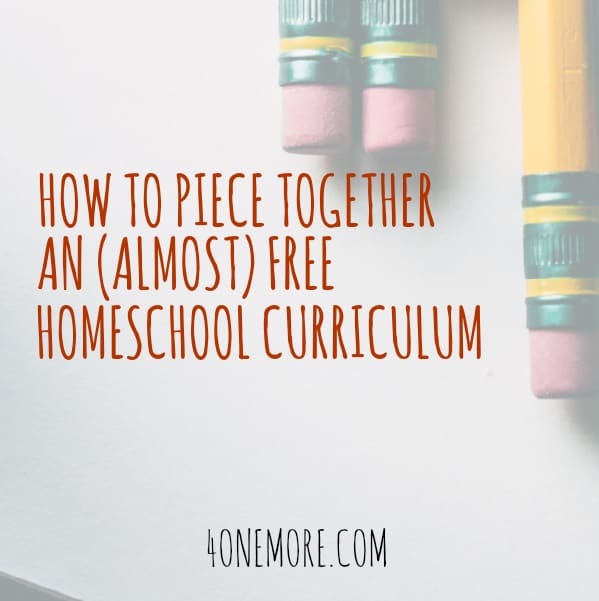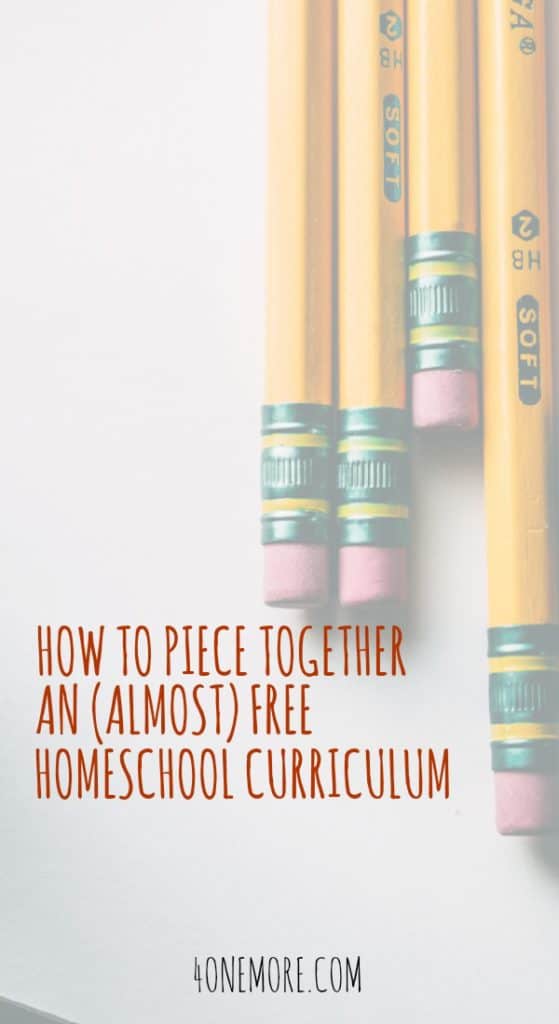Sure, there are complete homeschool curriculums that you could throw down $899 per kid and buy for next year. But that amount of money just seems ludicrous for, say, third grade homeschool. And if you have several kids to buy for, it might be impossible to come up with that amount of money.
And, what if you just don’t like a boxed curriculum? What if you want more flexibility and freedom with choosing the topics your kids will learn this year? You’re not totally Charlotte Mason, or Classical, or textbook-based. Eclectic homeschooling just sounds like the right fit.
Maybe that’s you.
The problem is that many homeschool moms think that they need to buy an “official” curriculum from a well-known publisher so that they can convince themselves (or others) that their children are getting a legit education. But you can craft an impressive, challenging, comprehensive, and interesting curriculum for (almost) free.
Here’s how to make it work.

This post contains affiliate links for your convenience. I will receive a commission if you purchase from these links. Thank you
Here’s How To Piece Together an (Almost) Free Homeschool Curriculum for grades K-8
Know your WHY
Your goals and family-specific priorities will inform the choices you make for homeschool curriculum.
For example, your WHY may include situations like these:
- dealing with learning disability
- prefer Christian (or secular) worldview
- needs to be independent work
- curriculum needs to be usable by multiple ages
- prefer hands-on rather than workbook
- my child is gifted, so I need something that will challenge him above “grade-level”
- we are moving this year (or having a new baby, or dealing with health issues, or…), so it needs to be open and go and uncomplicated
Some of your WHY’s may change through the years. Some families start homeschooling because of a specific learning situation with one child and then find that they love the rhythm and flexibility of homeschool, especially when their child blossoms at home!
Narrow down a style or two that you are comfortable with
You don’t have to embrace a specific homeschool style in its entirety, but it is helpful to narrow down your best fits. This will help you choose the right approach to teaching each subject. If you can’t stand workbooks and structured homeschool, then you won’t be happy with using ABeka or Bob Jones for math. If you and your child will go crazy without a pre-made plan for what to do for science each day, then don’t try to plan your science curriculum based off of loads of printables you find on Pinterest. You will be sorry.
>>You can find a chart with the most common homeschool styles and links to curriculum that fit each style in my members-only resource library. It’s FREE to join! You can do that HERE.<<
Here are a few other things to consider about your choices. Do you prefer:
- open and go or teacher (mom) intensive
- secular or religious
- online or paper
- textbook or living book
List subjects you need (and want) to cover
This discussion pertains mainly to grades K-8. When your kids are in high school, you will have graduation requirements and credits and transcripts that will dictate some of your choices. But in grades K-8, your main goals are to stay sane while giving your kids the freedom to fall in love with learning. Don’t school it out of them. Kids are naturally curious and want to learn. Let’s not muddy the waters and make homeschooling harder than it needs to be.
Knowing that your kids will not master everything in the K-8 sequence is also liberating. You can read about that HERE.
Of course, always check your state laws regarding homeschooling.
The two core subjects that children do need to gain a high level of proficiency in are math and language arts. Let’s start with these.
MATH
If you invest some money in one place, I would purchase a math program or curriculum for each child. Ideally, you could purchase something that is reusable for a younger sibling another year. Or, if you’d rather go the totally free route, you could use Khan Academy or find a scope and sequence for that grade level and piece together your own plan.
To help you see how this might look for a third grader, here are three reasonable math programs you could choose from.
Bob Jones University Press 3rd grade math
Student worktext $30
Teacher’s Edition $75 (I would call this optional at the third grade level)
Tests & Answer Key $25 (I would also not purchase tests for my third grader)
BJUP Math Total cost for 3rd grade: $30-130
Saxon 3rd grade math
Home Study Kit $100
Teaching Textbooks for 3rd grade math
Complete online program $43.08 for a 12 month subscription
I asked some other homeschool bloggers to weigh in on their family’s favorite math curriculums, and you can see their recommendations HERE.
[thrive_leads id=’7444′]
LANGUAGE ARTS
Language Arts is a broad term that includes many skills. You can certainly find free resources to teach most of this. I’ve listed some free ideas and reasonably priced alternatives if you have some money in your budget. This is just the tip of the iceberg! Find valuable curriculum reviews over at CathyDuffyReviews.com
Phonics
If your child is in Kindergarten through second grade, phonics will play a big role in his language arts education. Any parent can teach their child to read. See if your library will order a copy of Teach Your Child to Read in 100 Easy Lessons or purchase online. You will come back to it over and over.
Reading
It’s amazing how many kids don’t have time to read because they’re in school all day. Say what?! No, it’s totally true. They’re too busy sitting through class discussions or filling in worksheets that many kids are not even able to read 30 minutes a day on a consistent basis. Public school teacher Donalyn Miller bemoans this fact in The Book Whisperer. Her philosophy of reading education, while discussed from a public school classroom perspective, makes even more sense to the homeschooler.
I would encourage you to add lots of wild and free reading into your homeschool day. Let your kids love reading and grow all their language skills by the simple pleasure of reading myriads of interesting books. Our reading time has been revolutionized by putting these ideas into practice. I used to spend lots of money on grade-specific reading curriculum. Not anymore. We use the library and enjoy reading now!
Vocabulary & Spelling
Once again, you can purchase grade-level-specific vocabulary and spelling books, or you can find lists online and teach these subjects for free! Check out vocabulary.com for grade lists, as well as lists related to Roots & Literature. They also include spelling bees and quizzes based on the list.
Grab a spiral notebook for each child. Here are some ideas:
- Write spelling word
- Look up the word and write 3 synonyms & 3 antonyms
- Use word in a sentence
- Analyze the word – does it have a root? prefix? suffix? is it plural? singular? is it derived from another language?
These disciplines are also picked up by readers. That’s why lots and lots of reading is essential to grow a solid language competency.
We use All About Spelling in our homeschool. If you’re looking for a cheaper alternative that you can use for multiple ages, try Spelling Power.
Grammar & Composition
You can pick up cheap grammar books online for each grade level. Or you can choose an ungraded, multi-level resource from Cathy Duffy’s site. Another idea is to look at a publisher’s scope & sequence for the grade level you need, and teach your child from that list.
Adding composition into your school day is as simple as “writing across the curriculum.” This means that writing is not a subject to be covered in isolation from the other subjects. Rather, your child can write summaries and descriptions that correspond to what you’re studying in history, science, art, literature, or even math!
DIY the Rest!
After you cover math and language arts, the rest in K-8 will be a matter of exposure. You can totally DIY a terrific homeschool learning experience for free, if you wish.
DIY SCIENCE IDEAS
- Nature walks & journaling
- Books from the library
- Follow your kids’ natural passions at the moment
- Science documentaries
- Science experiments
- Science Youtube Channels
- Taking care of pets and animals
- Health and nutrition
- grab a great Science Encyclopedia – this is really the only “science curriculum” you need in K-8!
DIY HISTORY IDEAS
- Field trips
- Books from the library
- Follow your kids’ natural passions at the moment
- History documentaries
- History YouTube Channels
- Read historical biographies
- Create maps & timelines
- grab a great History Encyclopedia – this is really the only “history curriculum” you need in K-8!
DIY ART & MUSIC IDEAS
- DeepSpaceSparkle tutorials
- Drawing with Children
- Story of the Orchestra
- Hoffman Academy piano lessons
Additional Resources:
Saving Money on Homeschool Curriculum
How Much Does It Really Cost To Homeschool?
Thrifty Girl’s Guide To Homeschooling on a Budget
My Resource Page: What We Love & Use
What was your biggest takeaway? Share below! Have you been inspired to piece together a homeschool curriculum for your child? You can do it!


